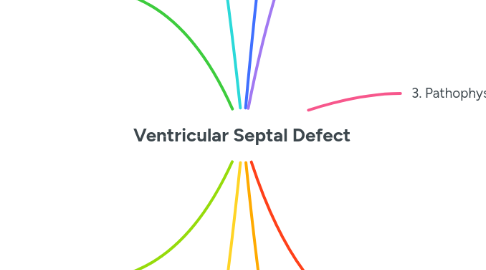
1. 6. Complications
1.1. Heart failure
1.1.1. Minimal short term risk when seen alone and with smaller defects (Roger, 2023). Long term risks include heart failure.The left to right shunting of blood causes oxygenated blood to go into the right side of the heart from the left which increases pulmonary blood flow without actually decreasing the muscular function of the heart (Rogers, 2023).
1.2. Infective Endocarditis
1.2.1. Patients typically requiring surgical intervention without spontaneous closure will need antibiotic prophylaxis to prevent this complication (Leifer, 2023).
1.3. Pulmonary Hypertension
1.3.1. If untreated can develop over years of increased blood flow in pulmonary circulation (Rogers, 2023). Irreverisble pulmonary hypertension known as Eisenmenger Snydrome occurs over time as the left to rught shunt begins to shift to a right to left shunt due to heart dilation (Meng et al., 2024),
2. 7. Treatment Approaches
2.1. Small defects may close within the first two years of life, with larger defects or those causing significant symptoms requiring early surgical intervention with cardiac catherization using a synthetic patch for closure or with significant defects requiring open heart with use of cardiopulmonary bypass (Rogers, 2023). Treatment should involve care that is tailored around promoting optimal growth and development for the child.
3. 8. Patient Education
3.1. Caregivers are educated on signs and symptoms of heart failure, when to call the provider, and when to go to ED such as with signs of respiratory distress, cyanosis, and tachycardia (Leifer, 2023). The family will be educated on follow up appointments with cardiology and on surgical intervention pre-op teaching and post op teaching if the defect requires early surgical intervention. Important aspects of education include dental care, prophyalactic antiobiotics, immunizations, anticipatory guidance, and nutrition (Leifer, 2023).
4. References
4.1. Dlugasch, L., & Story, L. (2024). Applied Pathophysiology for the Advanced Practice Nurse. Jones & Bartlett Learning.
4.2. Leifer, G. (2023). Introduction To Maternity And Pediatric Nursing. (9th ed). Elsevier.
4.3. Meng, X., Song, M., Zhang, K., Lu, W., Cheng Zhang, Y. L., & Zhang, Y. (2024). Congenital heart disease: types, pathophysiology, diagnosis, and treatment options. MedComm, 5(7). https://doi.org/10.1002/mco2.631
4.4. Rogers, J. (2023). McCance & Huether’s pathophysiology (9th ed.). Elsevier Health Sciences.
4.5. Schub, T., & Woten, M. (2024). Heart Defects, Congenital: Therapy -- Surgery in Children. CINAHL Nursing Guide.
5. 1. Disease/condition overview
5.1. Definition
5.1.1. A congenital cardiac defect causing a hole in the septum of the ventricules; is considered a acyanotic defect that increases pulmonary blood flow (AHA, n.d.; Rogers, 2023). Is one of four defects in Tetralogy of Fallot but can also be a defect seen by itself (Leifer, 2023).
5.2. Risk Factors
5.2.1. Inborn errors of chromosomes such as Trisomy 13, 18, 21, Cri du chat syndrome, and 22g11.2 deletion syndrome, advanced maternal age, alcohol, substance, medications, rubella infection and diabetes mellitus present in mother (Leifer, 2023; Rogers, 2023).
6. 2. Etiology
6.1. Primary Cause
6.1.1. Abnormal fetal development of the heart involving the ventricles.
6.2. Contributing Factors
6.2.1. .Genetic, environmental, maternal nutritional status, prenatal care, and maternal co morbidities as well as familiar risk and certain teratogenic medications play a role as well (Leifer, 2023). DIabetes Mellitus, alcohol use, advanced maternal age, and premature birth (Rogers, 2023). Higher rates are seen in siblings of children with congenital heart defects (Rogers, 2023).
